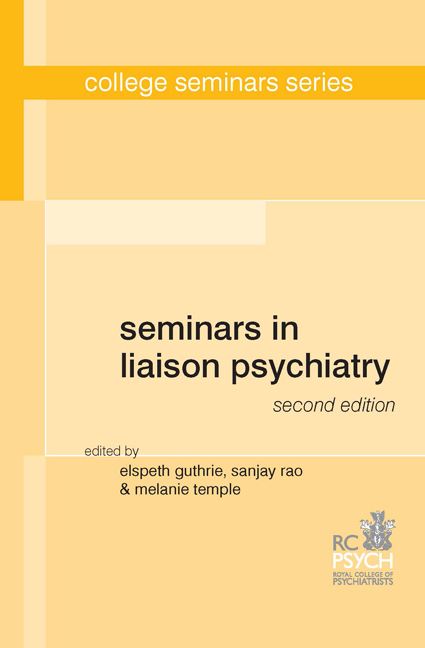Book contents
- Frontmatter
- Contents
- Abbreviations
- List of boxes, tables and figures
- List of contributors
- 1 Basic skills and competencies in liaison psychiatry
- 2 The liaison psychiatry curriculum
- 3 Classification and diagnosis
- 4 Capacity and consent
- 5 Psychological reaction to physical illness
- 6 Medically unexplained symptoms
- 7 Alcohol and substance use in the general hospital
- 8 Accident and emergency psychiatry and self-harm
- 9 Perinatal psychiatry
- 10 General medicine and its specialties
- 11 Liaison psychiatry and surgery
- 12 Neuropsychiatry for liaison psychiatrists
- 13 Psycho-oncology
- 14 Palliative care psychiatry
- 15 Sleep disorders
- 16 Weight- and eating-related issues in liaison psychiatry
- 17 Disaster management
- 18 Liaison psychiatry and older people
- 19 Paediatric liaison psychiatry
- 20 Primary care and management of long-term conditions
- 21 Occupational medicine
- 22 HIV and liaison psychiatry
- 23 Sexual dysfunction
- 24 Psychopharmacology in the medically ill
- 25 Psychological treatments in liaison psychiatry
- 26 Research, audit and rating scales
- 27 Service models
- 28 Developing liaison psychiatry services
- 29 Multiple choice questions and extended matching items
- Appendix 1 Specific competencies
- Appendix 2 Learning objectives with assessment guidance
- Index
15 - Sleep disorders
- Frontmatter
- Contents
- Abbreviations
- List of boxes, tables and figures
- List of contributors
- 1 Basic skills and competencies in liaison psychiatry
- 2 The liaison psychiatry curriculum
- 3 Classification and diagnosis
- 4 Capacity and consent
- 5 Psychological reaction to physical illness
- 6 Medically unexplained symptoms
- 7 Alcohol and substance use in the general hospital
- 8 Accident and emergency psychiatry and self-harm
- 9 Perinatal psychiatry
- 10 General medicine and its specialties
- 11 Liaison psychiatry and surgery
- 12 Neuropsychiatry for liaison psychiatrists
- 13 Psycho-oncology
- 14 Palliative care psychiatry
- 15 Sleep disorders
- 16 Weight- and eating-related issues in liaison psychiatry
- 17 Disaster management
- 18 Liaison psychiatry and older people
- 19 Paediatric liaison psychiatry
- 20 Primary care and management of long-term conditions
- 21 Occupational medicine
- 22 HIV and liaison psychiatry
- 23 Sexual dysfunction
- 24 Psychopharmacology in the medically ill
- 25 Psychological treatments in liaison psychiatry
- 26 Research, audit and rating scales
- 27 Service models
- 28 Developing liaison psychiatry services
- 29 Multiple choice questions and extended matching items
- Appendix 1 Specific competencies
- Appendix 2 Learning objectives with assessment guidance
- Index
Summary
The intriguing processes of sleep and dreaming have attracted attention from philosophers and artists for centuries, if not millennia. However, only in the past few decades has sleep medicine emerged as a credible and important scientific discipline worthy of attention both clinically and from research perspectives. Even now, it occupies a ‘Cinderella’ position within medical practice, despite increasing evidence that a disturbed sleep–wake cycle can directly damage physical, mental and emotional well-being. It is also clear that there is a circular relationship between sleep disruption and many ‘sleep toxins’, such as pain and disturbed mental health, which are, in turn, exaggerated by any resulting sleep deprivation. For example, insomnia may precipitate depression, anxiety or even psychosis rather than simply acting as a comorbid marker. Obesity, raised inflammatory markers and impaired cognition are further examples of common problems inextricably linked with chronically abnormal sleep (see Box 15.1 for proposed adverse effects of sleep disruption).
Paradoxically, the low profile of sleep disorders in medical education seems particularly apparent in psychiatry. Hopefully, this is changing. Most clinicians and, indeed, members of the public generally appreciate the importance of good-quality sleep, although the majority have little more than a basic understanding of its neurobiology. This chapter gives a broad outline of sleep and its disorders, with particular emphasis on those aspects germane to neuropsychiatry.
Normal v. abnormal sleep
Advances in our understanding of the neurobiology of sleep have challenged the traditional view that sleep is a passive or necessarily restful process. By contrast, rather than simply reflecting the absence of wakefulness, sleep is actively orchestrated with a highly reproducible and complex internal architecture (Frank, 2006). A typical pattern seen in a healthy adult is shown in Fig. 15.1. Episodes of rapid eye movement (REM) and non-rapid eye movement (non-REM) sleep recur through the night in four or five discrete cycles. It should be recognised that occasional arousals from nocturnal sleep may be regarded as normal and that seemingly random body movements or shifts in position occur regularly throughout the night. In REM sleep episodes, however, despite high levels of cerebral metabolic activity that loosely correspond to vivid dream mentation, general motor activity is profoundly suppressed and any observable movements are confined to occasional minor jerks.
- Type
- Chapter
- Information
- Seminars in Liaison Psychiatry , pp. 222 - 239Publisher: Royal College of PsychiatristsFirst published in: 2017



